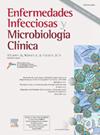根据“留下你的印记”方案,对医院急诊科新作出的艾滋病毒诊断进行描述
IF 2.5
4区 医学
Q3 INFECTIOUS DISEASES
Enfermedades infecciosas y microbiologia clinica
Pub Date : 2025-10-01
DOI:10.1016/j.eimc.2025.04.001
引用次数: 0
摘要
«留下你的印记»项目提出建议,当病人出现某些情况时,在急诊科(ED)进行艾滋病毒筛查。目前尚不清楚在急诊科诊断的患者的概况是否与流行病学报告中报道的普通人群相似。方法回顾性分析17例ED患者1年内新发HIV的特点。记录了人口统计数据(出生时的性别、年龄、出生国家)、性行为和风险行为、急诊科的诊断、过去5年的急诊次数、从急诊科到特定艾滋病毒咨询的时间,以及从急诊科到开始抗逆转录病毒治疗的时间。还收集了首次CD4和病毒载量的信息。结果共纳入169例患者。流动人口122例(72.2%),异性恋者57例(32.5%),注射吸毒为传播途径14例(8.3%)。一般人群报告的数据分别为49.8%、25.7%和1.7%。80例(47.3%)患者发现晚期诊断(卫生部报告数据为48.7%)。与西班牙人相比,移民更多的是女性(13.1%对6.4%),异性恋(38.5%对21.3%),免疫状况更差(中位CD4计数为310 [IQR 132-457]对444 [IQR 215-607])。结论:在诊断可能不寻求其他医疗保健水平的不同患者时,可发挥关键作用。本文章由计算机程序翻译,如有差异,请以英文原文为准。
Caracterización de los nuevos diagnósticos de VIH realizados en los servicios de urgencias hospitalarios a partir del programa «Deja tu huella»
Introduction
The «Leave your mark» program launched recommendations for HIV screening in emergency departments (ED) when patients presented with certain conditions. It is unknown whether the profile of patients diagnosed in the ED is similar to those reported for general population in epidemiological reports.
Methods
Retrospective study evaluating the characteristics of patients with new HIV diagnosed in 17 ED over a one-year period was developed. Demographic data (sex at birth, age, country of birth), sexual and risk behaviour, diagnosis in ED, number of emergency visits in previous 5 years, time from the ED to the specific HIV consultation, and from ED to start antiretroviral treatment were recorded. Information on the first CD4 and viral load was also collected.
Results
A total of 169 patients were included. There were 122 (72.2%) migrants, 57 (32.5%) heterosexual, and injection drug use was the transmission route in 14 (8.3%) cases. Data reported for the general population were 49.8%, 25.7%, and 1.7%, respectively. Late diagnosis was found in 80 (47.3%) patients (reported figures by the Ministry, 48.7%). Compared to Spanish, migrant were more frequently women (13.1% vs. 6.4%), heterosexual (38.5% vs. 21.3%), and had worse immunological status (median CD4 count of 310 [IQR 132-457] vs. 444 [IQR 215-607]).
Conclusion
ED can play a key role in diagnosing a different patient profile that may not seek care at other healthcare levels.
求助全文
通过发布文献求助,成功后即可免费获取论文全文。
去求助
来源期刊
CiteScore
2.10
自引率
8.00%
发文量
194
审稿时长
29 days
期刊介绍:
Hoy está universalmente reconocida la renovada y creciente importancia de la patología infecciosa: aparición de nuevos agentes patógenos, de cepas resistentes, de procesos con expresión clínica hasta ahora desconocida, de cuadros de una gran complejidad. Paralelamente, la Microbiología y la Infectología Clínicas han experimentado un gran desarrollo como respuesta al reto planteado por la actual patología infecciosa. Enfermedades Infecciosas y Microbiología Clínica es la Publicación Oficial de la Sociedad Española SEIMC. Cumple con la garantía científica de esta Sociedad, la doble función de difundir trabajos de investigación, tanto clínicos como microbiológicos, referidos a la patología infecciosa, y contribuye a la formación continuada de los interesados en aquella patología mediante artículos orientados a ese fin y elaborados por autores de la mayor calificación invitados por la revista.

 求助内容:
求助内容: 应助结果提醒方式:
应助结果提醒方式:


